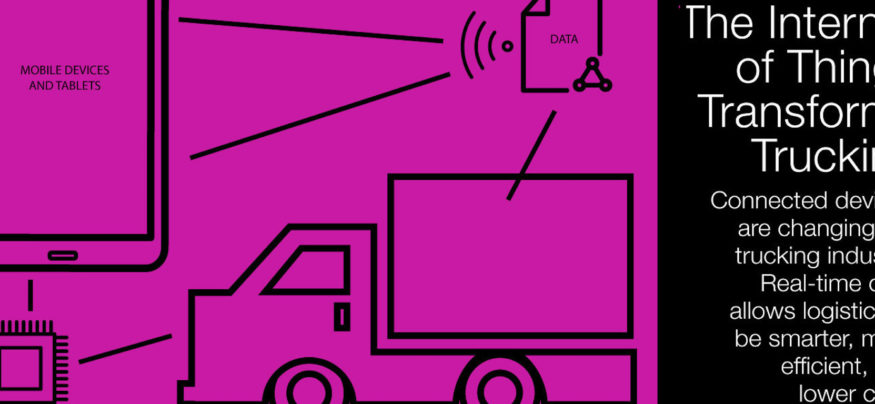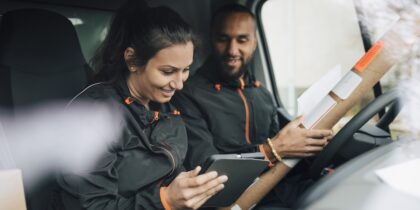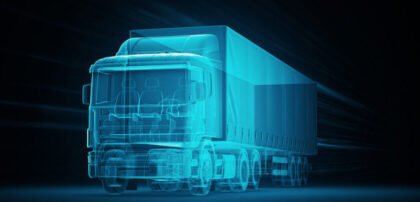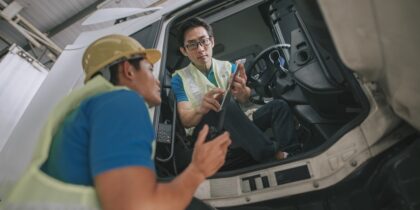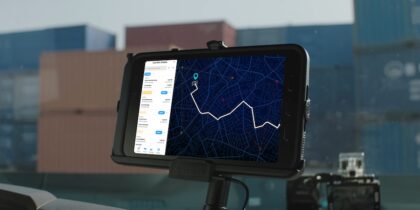As trucks travel interstate highways, onboard sensors collect, send and receive information via cloud-based fleet management systems. As technology advances, the truck is becoming a part of the broader Internet of Things (IoT) logistics ecosystem that could transform trucking and the logistics industry.
Over the next decade, the IoT in logistics is expected to generate $1.9 trillion in value, part of an overall $8 trillion in IoT value generated globally, according to the 2015 DHL and Cisco Internet of Things Trend Report.
According to the report, the logistics industry will unlock greater operational efficiency as IoT devices connect in real time the millions of shipments moved, tracked and stowed each day. In warehousing, connected pallets and products will drive smarter inventory management, improved service and lower costs. Mobile devices like smartphones and tablets can remove barriers to creating, accessing and sharing the data that’s generated by connecting trucks to the Internet of Things.
Connected Trucks Deliver Data
With IoT logistics, tracking and tracing goods becomes faster, more accurate, predictive and secure; while analytics from a connected fleet can predict asset failure and schedule maintenance checks automatically. Connecting drivers and delivery personnel with surrounding vehicles and people can help monetize and optimize empty “deadheads” to drive efficiency gains.
Vehicles that used to only transport freight are now delivering data as well, and lots of it. Today, trucks are becoming a mobile node in the Internet of Things, a two-way connection between the driver and the dispatcher that reduces costs and delays and delivers greater visibility to shippers and trucking companies. Trucking companies, shippers and drivers benefit from IoT logistics data that’s now available to them from mobile devices in the cab.
Connected with high-speed cellular Internet data from sensors on trucks, dispatchers can measure real-time fuel efficiency, and how drivers operate their vehicles — do they brake too late, or waste diesel on lead-foot starts? Fleet management systems can recommend the optimal speed for a route and how get the most mileage out of each gallon of fuel. GPS-equipped systems track driver routes, time spent loading and unloading and help manage hours of service compliance. User-generated input via smartphones and tablets can help truckers route around construction or congested areas.
For its fleet management solutions, Telogis — a leading provider of telematics, compliance and navigational software — has developed navigational communities that give drivers a channel to give feedback on the road, customer loading docks, weather and anything else that could impact the delivery schedule.
“Drivers tell us this is getting smarter every day, and the reality is the more feedback they provide, the system does become smarter,” says Erin Cave, vice president of product management, navigation and compliance at Telogis.
Sensor-equipped trucks can also tell maintenance crews when it’s time to bring a truck in for servicing brakes, tires, oil and other critical systems. With onboard sensors, the maintenance team can bring a truck in for service long before it might be sidelined by unexpected failures.
Connected Trucks Help Retain Drivers
Not too long ago, truck drivers saw mobile devices in the cab as an intrusion. But after a few hundred thousand miles on the road aided by a smartphone or tablet in the cab, many drivers won’t haul a load without an electronic logging device (ELD).
“Most companies, when they make the transition to ELD, have a group of drivers say they’re going to quit, and after 30 days of using the system, they won’t take a truck that doesn’t have one,” says Tom Bray, senior editor at J.J. Keller & Associates.
Drivers love the fact that IoT-linked trucks can help them do their jobs faster and safer. ELDs can dramatically cut the time spent filling out paper logbooks to comply with hours of service regulations. Load turnarounds can be faster with freight and locations that are tagged with RFID, NFC or Bluetooth low energy devices. Drivers can use tablets for electronic vehicle inspection reports, get basic troubleshooting and service instruction, stay up to date with training and use them for entertainment and communication in their off-duty hours.
Mobile apps allow managers and drivers to access reporting and management tools via smartphones and tablets. Managers can stay in touch while they’re on the go, with emergency alerts and dashboard reporting to stay on top of trends.
Telematics solution providers are developing analytics tools to manage the growing data stream. For instance, Omnitracs launched Omnitracs Tracking, an app that monitors truck driver location and speed and provides exception reporting if drivers perform unsafe maneuvers or exceed operating thresholds.
Gain Visibility with Connected Freight and Trucks
Beyond smart trucks, the next evolution of IoT logistics will see the entire supply chain linked with connected things. With falling costs for smart tags, pallets will talk to trailers, containers will talk to trucks and fleets could talk to fleets. Telematics sensors in trucks and multisensor tags on items transmit data on location, condition and whether a package has been opened. Sensors that measure the capacity of each load can provide additional insight into spare capacity in vehicles. The IoT data could then populate a central dashboard that focuses on identifying spare capacity on particular routes or destination pairs and analytics could recommend suggestions for consolidating and optimizing the route. This additional visibility would create fleet efficiencies, improve fuel economy and reduce deadhead miles, which account for up to 10 percent of truck miles.
With each link connected to the cloud, there will be an unprecedented level of supply chain visibility from dock to dock and every step in between.
